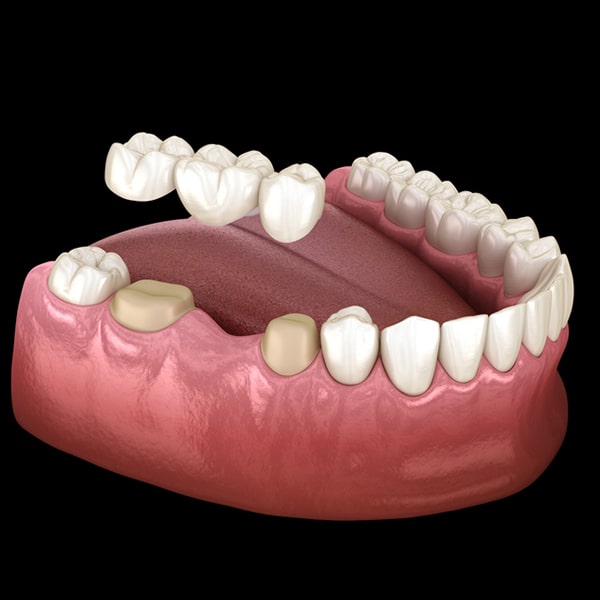Affordable Dental Bridges in Stratford, CT
What Is a Dental Bridge?
A dental bridge is a custom-made dental prosthesis fabricated to replace one or more missing teeth. It uses the teeth surrounding a space (abutments) to anchor and support a false tooth or teeth (pontic). The bridge is typically made of porcelain, ceramic, or other materials and is cemented onto the supporting teeth. If you have missing teeth, speak to a dentist today to find out if you are eligible for a dental bridge in Stratford, CT.
Discover more about dental bridges:
Appearance of a Dental Bridge
A dental bridge typically looks and feels like natural teeth. The abutment teeth are capped with crowns, which are connected to the false tooth or teeth, known as pontics. The pontics can be made of porcelain, ceramic, or other materials and are designed to match the color and shape of your natural teeth, often using precise dental crown color matching for a seamless look. Once in place, a dental bridge can blend seamlessly with your existing teeth and provide long-lasting results.
Alternatives to Dental Bridges
If a dental bridge isn’t the right solution for you, there are other options available. Partial dentures … Click to open this link in the same window … are one alternative, as they are removable false teeth that can be taken out for cleaning. Alternatively, a dental implant … Click to open this link in the same window … may be a viable option for some patients, as it involves surgically placing an artificial tooth root into the jawbone. Consulting with your dentist can help determine which solution is the most suitable for your individual needs.

The Process
A bridge is usually made in 2-3 visits by a dentist or prosthodontist. Dr. Gretzula will give you a more accurate timeline during your consultation.
-
The First Visit
The first visit consists of preparing the teeth that will support the bridge. The dentist will select a shade for the patient that matches the surrounding teeth. A local anesthetic (Novocain) may be administered, and the dentist will shape the teeth adjacent to the space as if they were to have crowns … Click to open this link in the same window … (caps).
An impression or mold of the teeth as well as surrounding and opposing teeth, will be taken. This will ensure that the new bridge will fit and function properly with the other teeth. At the end of the visit, a temporary bridge will be made out of acrylic or similar material and cemented using temporary cement. The temporary bridge will not only protect the prepared teeth but also provide better esthetics by having the space filled.
-
The Second Visit
At the next visit, the dentist will remove the temporary bridge and clean any cement or debris from the teeth. The dentist may elect to do a coping try at this time. Copings are the metal shells that will support the bridge. Porcelain is applied over the metal to allow the bridge to blend with the surrounding teeth. If the copings fit properly, they will be returned to the lab for the final porcelain application. The temporary bridge will be recemented until the next visit.
-
The Final Visit
The final visit involves cementing the bridge into place. The temporary bridge is removed, and any cement or debris is cleaned from the teeth. The finished bridge is placed over the teeth, and the dentist will check the fit, position, and appearance of the bridge. An X-ray … Click to open this link in the same window … may be taken to ensure the fit between the teeth and below the gum is accurate. Once it has been determined that the bridge is a good fit, it will be affixed to the teeth using strong cement.
Advantages of a Dental Bridge
There are several advantages that may make a bridge the right choice for a patient.
Porcelain bridges may mimic natural tooth esthetics very nicely. Because the bridge is cemented, patients also do not have to worry about removing it as they would with a denture … Click to open this link in the same window … . Cost may also be a deciding factor. Most insurance plans will cover a portion of the cost of the bridge, making it a less expensive alternative to a dental implant in CT … Click to open this link in the same window … .
The main disadvantage to having a bridge is the grinding of the adjacent teeth. Teeth that are otherwise sound and healthy need to be cut and shaped, removing valuable tooth enamel. If overcut, these teeth may become sensitive or painful and require root canals … Click to open this link in the same window … . A commitment must also be made to properly care for and clean the bridge to ensure that it lasts as long as possible before needing to be replaced.

If you’re looking for a top-rated “dental bridge dentist near me” then look no further than Hawley Lane Dental.
Dental Bridges FAQ
Get the answers you need.
-
Am I Eligible?
Dental bridges are an excellent solution for people who have one or more missing teeth due to tooth decay, gum disease, injury, or other congenital conditions. To qualify for a dental bridge, you must have healthy teeth on either side of the gap to support the abutment teeth. Dental bridges can also help prevent teeth from shifting, restore proper bite and chewing functions, and improve your smile. If you live in or nearby Stratford, speak to the dental professionals at Hawley Lane Dental … Click to open this link in the same window … to see if you’d be a good candidate for a dental bridge.
-
How Much Do Dental Bridges Cost?
The cost of a dental bridge in Connecticut will vary based on the number of missing teeth. Generally speaking, a dental bridge costs about $1700 per tooth in the bridge. For example, a three-unit bridge (two teeth supporting one missing tooth) costs approximately $5100, and a four-unit bridge (two teeth supporting two missing teeth) costs approximately $6800.
-
Why Might I Need a Dental Bridge?
Missing teeth can cause several problems, including difficulty in eating and speaking, discomfort, and self-consciousness. If left untreated, it can also lead to oral health issues, such as:
- Gum disease … Click to open this link in the same window …
- Tooth decay
- Jawbone loss
A dental bridge can help address these issues by filling in the gap and preventing teeth from shifting, restoring proper bite and chewing functions, and improving your overall oral health and confidence.
-
How Long Do Dental Bridges Last?
The new bridge may last 10 or more years, depending on how it is cared for. One of the most common reasons for replacing a bridge is new decay forming around the abutment teeth. This most often occurs when food and plaque are not properly removed from under the false pontic tooth and are trapped against the gum and supporting teeth. Because the pontic tooth is affixed to the adjacent teeth, floss cannot be snapped between the teeth.
The use of a floss threader is essential for cleaning the space between the pontic and the gum. The floss is passed through the plastic threader (similar to threading a needle) and the tip is passed between the pontic and the gum below. This allows the floss to clean any food or debris that may be trapped. Not only will this keep the bridge clean but it will also prevent a bad odor or taste from forming from any trapped food.
-
Monday - 9:00am–5:00pm
-
Tuesday - 8:00am–5:00pm
-
Wednesday - 8:00am–5:00pm
-
Thursday - 8:00am–5:00pm
-
Friday - 8:00am–5:00pm



